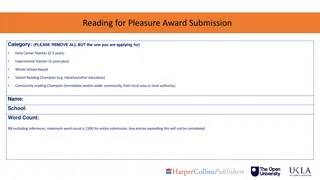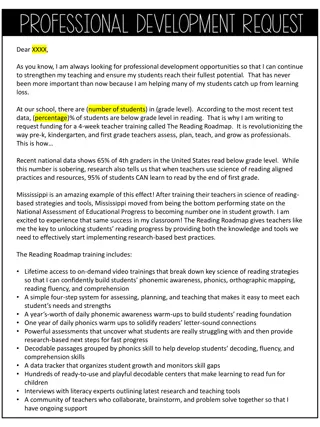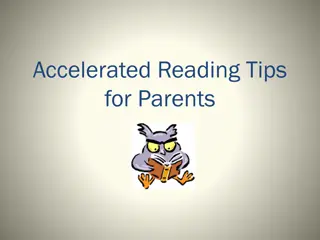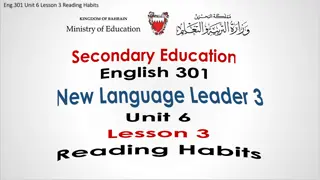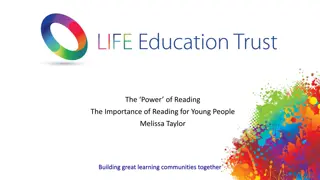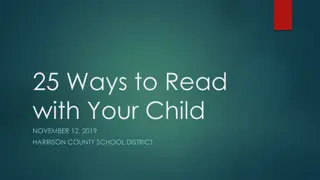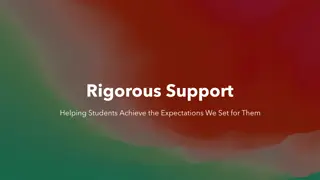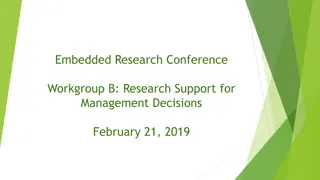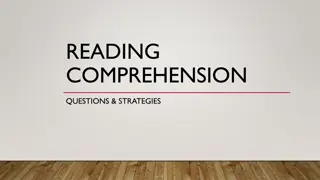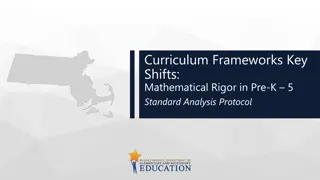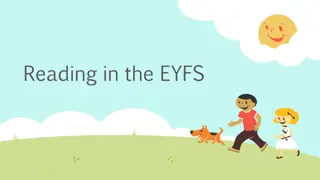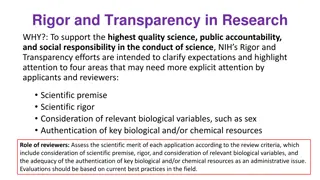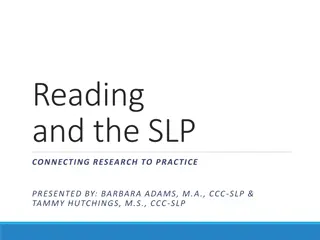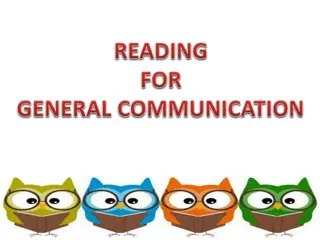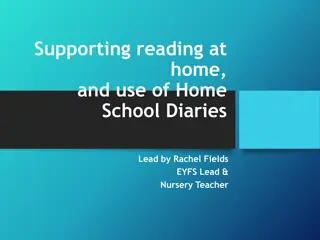Understanding Rigor in Reading Education
Rigor in reading education is a topic of increasing interest due to dissatisfactions with current educational practices. This article delves into the meanings and implications of rigor, discussing how it plays out in reading instruction and highlighting the need for guidance in making reading materials harder yet accessible. The text challenges traditional notions of rigor, pointing out that mere difficulty does not guarantee improved learning outcomes. Instead, it emphasizes the importance of text complexity and the application of comprehension skills in context as key factors in enhancing students' reading abilities.
Download Presentation

Please find below an Image/Link to download the presentation.
The content on the website is provided AS IS for your information and personal use only. It may not be sold, licensed, or shared on other websites without obtaining consent from the author. Download presentation by click this link. If you encounter any issues during the download, it is possible that the publisher has removed the file from their server.
E N D
Presentation Transcript
What Does Rigor Really Mean in Reading Education? Timothy Shanahan University of Illinois at Chicago www.shanahanonliteracy.com
Dissatisfaction with Education NAEP scores International comparisons College faculty polls Employer polls Military recruitment problems
Calls for Rigor School Reform Groups U.S. Department of Education Common Core State Standards
Definitions of Rigor Merriam-Webster: 1. Harsh inflexibility in opinion, temper, judgment (severity) 2. The quality of being unyielding, inflexible (strictness) Severity of life (austerity) 3.
How Rigor Plays Out in Reading Weekly or biweekly testing Teaching large numbers of sight words to beginners Fast phonics Lots of homework Teaching the standards Harder and more
Problems with Rigor All of these examples show teachers requiring that students do more or do harder things But in none of these examples is there any certainty or likelihood that kids will learn anymore than they do now
Harder But with Guidance Text complexity Recognition that comprehension skills are meaningless outside of the context of particular levels of text complexity Students can apply almost any comprehension skill in a simple text, and almost none in a sufficiently complex text Reading ability is more related to the texts that can be read than to the skills which can be applied
No performance differences due to question types (skills)
No performance differences due to question types (cont.)
Reconceptualizing Reading Reading is not the ability to answer certain kinds of questions Reading is the ability to make sense of ideas expressed in text the ability to negotiate the linguistic and conceptual barriers or affordances of a text
Texts Are Getting Harder Since 2010 all/most publishers have started making their Reading/ELA textbooks markedly harder from grades 2-12 Even non-textbook approaches like Guided Reading have started to match kids to harder books (despite their basic premise that students should be in books that match their reading levels ) Harder texts included in online teacher lesson plan sharing websites like Teachers Pay Teachers
Standards assign higher difficulty levels in grades 2-12 ATOS, Degrees of Reading Power, Flesch-Kincaid, Lexiles, Reading Maturity, Source Reader Set higher than in the past (75-89% comprehension to ???) Grades Lexile Bands CCSS Bands K-1 2-3 4-5 N/A N/A 450L-730L 640L-850L 420L-820L 740L-1010L 6-8 9-10 11-CCR 860L-1010L 960L-1120L 1070L-1220L 925L-1185L 1050L-1335L 1185L-1385L
Problems Many administrators think they have solved the reading rigor problem by adopting new textbooks or by requiring that particular Lexile levels of text be used The texts are harder so the kids will learn more But is that how it really works?
Four Common Classroom Responses to Text Difficulty Move students to easier text (so called instructional level ) Read text to students (communicates the information, but doesn t increase student reading ability) Tell students what texts say (same as reading to kids in its impact) Ignore the problem (more drawbacks than the previous approaches)
Need for Scaffolding Many administrators believe they have solved the rigor problem by purchasing textbooks that have higher Lexiles than in the past But if teachers do not know how to scaffold student reading with these harder books without reading the texts to the students or telling them what the book say then learning will not be the result
Substantial Evidence Bonfiglio, Daly, Persampieri, & Andersen, 2006 Burns, 2007 Burns, Dean, & Foley, 2004 Carney, Anderson, Blackburn, & Blessings, 1984 Daly & Martens, 1994 Eckert, Ardoin, Daisey, & Scarola, 2000 Faulkner & Levy, 1999 Gickling & Armstrong, 1978 Hall, Sabey, & McClellan, 2005
Substantial Evidence (cont.) Levy, Nicholls, & Kohen, 1993 McComas, Wacker, & Cooper, 1996 Neill, 1979 O Shea, Sindelar, & O Shea, 1985 Pany & McCoy, 1988 Rasinski, 1990 Reitsma, 1988 Rose & Beattie, 1986 Sanford & Horner, 2013
Substantial Evidence (cont.) Sindelar, Monda, & O Shea, 1990 Smith, 1979 Stoddard, Valcante, Sindelar, O Shea, et al., 1993 Taylor, Wade, & Yekovich, 1985 Turpie & Paratore, 1995 VanWagenen, Williams, & McLaughlin, 1994 Weinstein & Cooke, 1992 Wixson, 1986
Scaffolding Challenging Text Scaffolding Text Features Complexity of ideas/content Match of text and reader prior knowledge Complexity of vocabulary Complexity of syntax Complexity of coherence Familiarity of genre demands Complexity of text organization Subtlety of author s tone Sophistication of literary devices or data-presentation devices
Scaffolding Challenging Text Other Approaches Provide sufficient fluency Use stair-steps or apprentice texts Teach comprehension strategies Motivation
Scaffolding Resources Shanahan, T., Fisher, D., & Frey, N. (2012), March. The challenge of challenging text. Educational Leadership. Shanahan, T. (2013). Letting the text take center stage. American Educator.
Not necessarily more But more thorough In the name of rigor, many programs are increasing the numbers of sight words that they are teaching particularly in kindergarten Another manifestation is to accelerate phonics learning fast phonics The idea is that these efforts will make kids better readers earlier in the past
But is that how it really works? Sight vocabulary refers to words that someone can read without obvious mediation Sight vocabulary appears to be recognized rather decoded Sight vocabulary learning initially depends upon rote memorization, and tends to focus heavily on high frequency words Expanding the amount of sight vocabulary that we try to teach shifts early reading from being mainly about decoding to being more about memorization
Sight Vocabulary National Academy of Sciences (1998) concluded that kindergartners should be expected to learn about 15-20 words (including their names) And at Grade 1, students should master the hundred most frequent words, along with being able to decode perhaps another 400-500 Analysis suggests that even supposedly non-decodable words are at least partially decodable and that decoding progress seems to speed sight vocabulary acquisition
50 Most Frequent Words the you are be by we an if of that as this words when each and it with have but your which a he his from not can she to was they or what said do in for at one all there how is on it had were use their
Phonetically Regular Words the you are be by we an if of that as this words when each and it with have but your which a he his from not can she to was they or what said do in for at one all there how is on it had were use their
Phonetically Regular Word Parts the you are be by we an if of that as this words when each and it with have but your which a he his from not can she to was they or what said do in for at one all there how is on it had were use their
Decoding, Not Memorization Instead of having kindergartners memorizing 92 words, the rigorous approach would be to limit this to a much smaller number of words With a substantial investment in early decoding instruction Getting little ones to memorize large numbers of words is not rigorous, it is a distraction from real rigor
But Not Fast Phonics A related idea about early rigor is to speed up the phonics sequence The National Reading Panel (2000) found that teaching phonemic awareness in K-1 and phonics in Grades K-2 improved decoding, fluency, spelling, and reading comprehension NRP found 3 years of phonics to be more beneficial than 2 years of phonics Phonics programs teach a small number of sound-symbol relations/spelling patterns the issue is whether to intro them fast or teach them thoroughly
Aggressive, But Intelligently Aggressive Studies show that young children who fail to progress well in early reading learning continue to lag academically Consequently, a number of measures have been developed to allow for monitoring of early literacy skills (e.g., DIBELS, TPRI, PALS, AIMSweb) In the name of rigor, many districts/schools/states have mandated frequent testing in the primary grades
But does that make sense? The idea certainly sounds rigorous: monitor student learning closely, so that no one slips through the cracks Test kids weekly and you ll always no how they are progressing, right? Unfortunately, assuming perfectly reliable tests does not make them perfectly reliable In many fields (e.g., nutrition, investing), early or frequent assessment appears to cause more problems than it solves and the same is true with early reading assessment
Standard Error of Measurement All tests, including early reading monitors, have standard errors of measurement (SEM) Tests do not arrive at a true score but an approximate score If students were tested repeatedly with no learning or forgetting the scores would change You need to pay attention to normal rate of growth in the tested skill and the SEM of the test in most cases, you ll find that you can t test usefully more than 2-4 times per year
Local Norms If you really want to be rigorous in this early testing, use your data to develop local norms Each of these tests has target or cut scores that are supposed to indicate that students are on-track to succeed But that is on average how is it working in your district? Analyze your data and adjust those cut-scores so that you are increasing educational opportunity for students who are likely to fail in your system
Rigor is Not about Making Instruction Look Like a Test Many schools have attempted to improve achievement by focusing teaching on what will be tested For example, writing tends not to get as much emphasis as reading when it comes to testing so principals often want teachers to prioritize reading over writing
Writing to Comprehend Graham & Hebert (2010) reviewed more than 100 studies Writing about text improves comprehension and learning from text (more than 93% of the outcomes were positive) Writing about text was more powerful than just reading Writing about text was more powerful than reading and rereading Writing about text was more powerful than reading and discussing
Why we learn from writing Writing about text is effective because it encourages deeper thinking about ideas Requires students to draw on their own knowledge and experience Helps them to consolidate and review information Inspires the reformulation of thinking Requires the organization and integration of ideas Fosters explicitness Facilitates reflection Encourages personal involvement Requires translation into one s own words
Writing about Text Engage students in writing To text models Summaries Analysis and critique Synthesis
What About Eternal Verities? Encouraging use of and growth in students oral language. Teaching vocabulary. Focusing attention on meaning prior to, during, and after reading. Guiding students to connect text with prior knowledge. Teaching students to use reading comprehension strategies. Building world/domain/content knowledge. Focusing on higher order thinking.
Title I Study Despite the rhetoric, how focused on rigor are we? U.S. Department of Education study released earlier this year We conducted 4 half-days of observation in more than 1000 preschool and primary grade classrooms We identified Title I schools that consistently scored relatively high in reading along with randomly selected Title I schools from the same districts
How often did these take place? Allowed adequate wait time .76 Asked open-ended questions .68 Had students speak with partners .03 Had students speak with peers (<4 mins) .08 Had students speak with peers (>4 mins) .04 Students wrote 1 sentence or more .15 Students wrote about text content .05 Teachers asked questions .80
How often did these take place? (cont.) Pre-reading talked about text content .26 Pre-reading talked about reading strategies .04 Pre-reading talked about vocabulary .05 During reading, talked about text content .33 During reading, talked about reading strategies .06 During reading talked about vocabulary .10 After reading, talked about text content .16 After reading, talked about reading strategies .03 After reading, talked about vocabulary .03
How often did these take place? (cont.) Number of minutes focused on world knowledge (about 3.6 minutes out of 15) Number of minutes focused on higher level thinking (about 2.4 minutes out of 15)
Title I Study Findings Those behaviors are related to growth in reading comprehension and oral language development But most of those behaviors are rare in our classrooms
Conclusions If you really want to be rigorous... It is fine to teach things that are harder, but provide adequate and appropriate guidance 1. Rigor doesn t always mean more, but more thorough (hurrying through a lot of skills is not rigorous) 2. Be aggressive about kids learning, but intelligently rigorous (the idea is to be aggressive not to look aggressive) 3. Don t be so focused on test outcomes that you neglect writing, social studies, and science 4.
Conclusions (cont.) If you really want to be rigorous... 5. Build oral language and teach vocabulary 6. Emphasize the mastery of world knowledge 7. Engage kids in higher order thinking 8. Emphasize meaning before, during, and after reading 9. Help kids connect content with their own knowledge 10. Teach students to use comprehension strategies
What Does Rigor Really Mean in Reading Education? Timothy Shanahan University of Illinois at Chicago www.shanahanonliteracy.com




